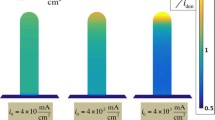Abstract
The laws of formation of a continuous deposit layer at a given direct current are considered. Equations are analyzed to calculate the time dependences of overpotential for instantaneous nucleation with kinetic or diffusion control of new-phase growth. The calculated dependences are compared with the experimental ones obtained for silicon electrodeposition from a fluoride–chloride melt.



Similar content being viewed by others
REFERENCES
B. R. Scharifker and G. J. Hills, “Theoretical and experimental studies of multiple nucleation,” Electrochim. Acta 28 (7), 879–889 (1983).
B. R. Scharifker and J. Mostany, “Three-dimensional nucleation with diffusion controlled growth. Part I. Number density of active sites and nucleation rates per site,” J. Electroanal. Chem. 177, 13–23 (1984).
V. A. Isaev and A. N. Baraboshkin, “Three-dimensional electrochemical phase formation,” J. Electroanal. Chem. 377, 33–37 (1994).
V. A. Isaev, Electrochemical Phase Formation (UrO RAN, Yekaterinburg, 2007).
V. A. Isaev, O. V. Grishenkova, and Yu. P. Zaykov, “Analysis of the geometrical-probabilistic models of electrocrystallization,” Russ. Metall. (Metally), 2016 (8), 776–784 (2016).
V. A. Isaev and O. V. Grishenkova, “Kinetics of electrochemical nucleation and growth,” Electrochem. Comm. 3, 500–504 (2001).
V. A. Isaev and O. V. Grishenkova, “Galvanostatic phase formation,” J. Solid State Electrochem. 18, 2383–2386 (2014).
A. N. Kolmogorov, “On the statistical theory of metal crystallization,” Izv. Akad. Nauk SSSR. Ser. Mat., No. 3, 355–359 (1937).
V. Z. Belenkii, Geometric-Probabilistic Models of Crystallization. Phenomenological Approach (Nauka, Moscow, 1980).
C. Johans, K. Kontturi, and D. J. Schiffrin, “Nucleation at liquid/liquid interfaces: galvanostatic study,” J. Electroanal. Chem. 526, 29–35 (2002).
Yu. P. Zaykov, S. I. Zhuk, A. V. Isakov, O. V. Grishenkova, and V. A. Isaev, “Electrochemical nucleation and growth of silicon in the KF–KCl–K2SiF6 melt,” J. Solid State Electrochem. 19, 1341–1345 (2015).
S. I. Zhuk, V. A. Isaev, O. V. Grishenkova, A. V. Isakov, A. P. Apisarov, and Yu. P. Zaykov, “Silicon electrodeposition from K2SiF6 and SiO2 containing chloride-fluoride melts,” J. Serbian Chem. Soc. 82, 51–62 (2017).
ACKNOWLEDGMENTS
This work was supported by the Russian Science Foundation, project no. 16-13-00061.
Author information
Authors and Affiliations
Corresponding author
Additional information
Translated by K. Shakhlevich
Rights and permissions
About this article
Cite this article
Isaev, V.A., Grishenkova, O.V., Laptev, M.V. et al. Formation of an Electrode Deposit under Galvanostatic Conditions. Russ. Metall. 2018, 763–766 (2018). https://doi.org/10.1134/S0036029518080086
Received:
Published:
Issue Date:
DOI: https://doi.org/10.1134/S0036029518080086



